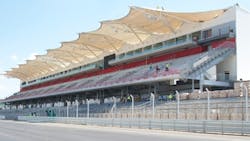Austin, TX Racetrack Opens Soon, With Plenty of Indoor Comfort
This fall, thousands of people will attend the 2012 Formula 1 United States Grand Prix, at the new Circuit of The Americas Formula 1 racetrack nine miles outside Austin, TX. Even though the event is scheduled for Nov. 16-18, race fans, drivers, crew members and media personnel probably won’t notice the ductwork or airflow created to make their spectator environment comfortable. For months prior to the warm-up lap, sheet metal workers from Porter Company, located just outside Austin, designed an HVAC system that would keep race fans, drivers, and crews comfortable for many races to come.
Built as an all-purpose facility, it is the only Fédération Internationale de l’Automobile (FIA)-certified Grade 1 track in the U.S., and one of 26 Grade 1-certified motorsports facilities in the world. Prior to the opening, the facility was already contracted to host the Formula 1 United States Grand Prix through 2021 and V8 Supercars from 2013 to 2018.
The more than 700 construction workers from 25 contractors employed on the site at any given time were presented with a hefty task and even a more important deadline. The facility includes a 40,000 sq.ft. media/conference center; a three-level, 270,000 sq.ft. pit building that can accommodate 5,000 people; a three-story permanent grandstand; a 5,000 sq.ft. medical center with helicopter landing area, enclosed ambulance bay and outdoor chemical show; and a live outdoor music entertainment area.
Porter Company detailers had to adjust from designing hospitals, commercial buildings and office complexes to creating ductwork that would work with the aesthetics architects had in mind, which included varying ceiling heights and structural enhancements.
The ductwork for the grandstand, pit building, and media center was designed and installed by Porter Company workers. Their biggest challenge was to design the HVAC systems to work according to the architect’s vision. Using ITI’s Benchmark building information modeling (BIM) software, Porter Company detailers had to adjust from designing hospitals, commercial buildings and office complexes to creating ductwork that would work with the aesthetics architects had in mind, which included varying ceiling heights and structural enhancements.
“On most jobs, you have one ceiling height and you have plenty of room to design your duct, but every job is different from the other. It made it really interesting to design the ductwork,” according to George Plane, Porter Company HVAC detailer. “Beams weaved in and out of each other. It took a lot of thinking to rework it all and avoid all the steel. We had to run our duct high in the structure to keep with how they needed it to look.”
The Benchmark BIM software made the challenges easier to navigate for the detailers, who could spot problems in the design and fix them before the ductwork was fabricated at the Porter Company shop, transported to the jobsite and installed. Before three-dimensional building modeling, many problems weren’t detected until everything arrived on the jobsite for installation, a waste of time, money and resources.
Looking at the numbers and tonnage used for the project, completion of the project on time is a feat in and of itself.
Once the design was complete, approximately 36 sheet metal workers based out of Austin’s Local 67 also installed 350,000 pounds of ductwork along with 20 rooftop air conditioning units on the pit building, which includes a garage area and suites and lounges for crews and racers; 40 rooftop units at the grandstand, of which three floors include a kitchen area, lounge and bar, and VIP suites; and the roof support structure on the media center.
The Trane cold air systems with supply, exhaust, and return ranged from 1.5- to 40-ton units. The 270,000 sq.ft. pit building alone required one each of the 7.5-ton, 12.5-ton and 15-ton units, five 17.5-ton units, two 30-ton units, two 35-ton units and eight 40-ton units, which create 12,000 cubic feet per minute of air flow (CFM). Units are operated by Siemens electronic control systems.
Where all the units would serve the buildings the best, as well as the CFMs needed for the particular area, were included in the design. In HVAC design, the ductwork can fit the building perfectly, but if it compromises airflow, the system is a failure. Balancing design with CFMs was another challenge detailers had to overcome.
“It was finding the amount of space we had to run our duct and calculating the CFMs we needed to run,” Plane says. “It was almost a nightmare on some days. We had to do it multiple times to get it the way they wanted it, so it was work. It was also a fun project.”
